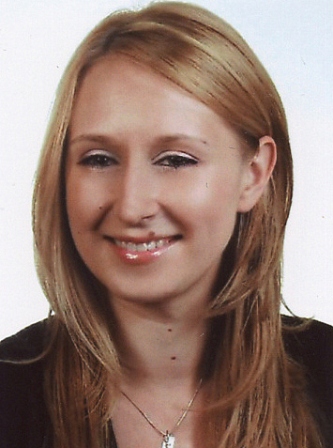 |
|
Zakład i laboratorium
Zakład: Zakład Biogeochemii Środowiska Przyrodniczego
Zainteresowania naukowe:
- emisja gazów cieplarnianych w procesach oczyszczania ścieków oraz zagospodarowania osadów
- skład osadu czynnego w zależności od rożnych aspektów technologii oczyszczania ścieków
- zastosowania elektronicznego nosa (e-nosa) do badań emisji odorów oraz określenia stanu wilgotności gleby
- wpływ płuczek powiertniczych (z gazu łupkowego) na proces oczyszczania ścieków oraz skład osadu czynnego
Uzyskane stopnie naukowe:
2011 inżynier sanitarny, specjalność: Instalacje i Sieci Sanitarne
Tytuł pracy: Projekt bioreaktora typu SBR do badań laboratoryjnych właściwości osadu czynnego oraz przebiegu procesu oczyszczania
2012 magister inżynier, specjalność: Technologia Wody i Oczyszczanie Ścieków
Tytuł pracy: Badania sprawności procesu oczyszczania ścieków miejskich metodą osadu czynnego w sekwencyjnym reaktorze porcjowym w skali laboratoryjnej
2013 magister inżynier, specjalność: Informatyka w Inżynierii Środowiska
Tytuł pracy: Wykorzystanie symulatora GPS-X do modelowania pracy laboratoryjnego bioreaktora typu SBR
2013 magister inżynier, specjalność: Zaopatrzenie w Wodę i Usuwanie Ścieków
Tytuł pracy: Ocena jakości wód rzeki Bystrzycy i ścieków deszczowych do niej odprowadzanych
2016 doktor nauk rolniczych Instytut Agrofizyki im. B. Dobrzańskiego PAN w Lublinie
Tytuł pracy: Emisja metanu i ditlenku węgla podczas oczyszczania ścieków osadem czynnym w bioreaktorze typu SBR (doświadczenia modelowe)
Stypendia i staże:
- 2008 Węgry, University of Miskolc, Depatment of Analysis of the Institute of Mathematics, Pobyt w ramach program: “CEEPUS Summer University”
- 2008-2012 Stypendium Ministra Nauki i Szkolnictwa Wyższego za osiągnięcia w nauce
- 2015/2016 Stypendium z „Miejskiego programu stypendialnego dla studentów i doktorantów”
- 2015-2017 Ukraina, Instytut Zoologii im. Schmalhausena NANU. Pobyty w ramach współpracy naukowej PAN –NANU (Polish Ukraine Joint Research Project „Ecological analysis of activated sludge and periphyton communities in wastewater treatment”)
Wybrane projekty naukowe:
- 2012-2014 Diamentowy Grant 0013/DIA/2012/41. Badania bioindykacyjne wybranych parametrów procesu oczyszczania ścieków miejskich bazujące na zbiorowiskach pektonu, błony biologicznej oraz osadu czynnego – Kierownik projektu
- 2013-2015 BLUE GAS-BG1/SOIL/2013 „Optymalizacja metod zagospodarowania odpadów powiertniczych” – wykonawca
- 2014/2015 Hackathonbridge. Poland to Ukraine. Implementacja dwóch biznes-gier dla przedsiębiorców w dziedzinie zagospodarowania odpadów w Polsce i Ukrainie oraz adaptacji zmian klimatycznych – Koordynator polskiej strony projektu
- 2015-2017 Projekt międzynarodowy w ramach porozumienia o współpracy naukowej między PAN i NANU (Ukraina): „Ecological analysis of activated sludge and periphyton communities in wastewater treatment „ – od 2017 Kierownik projektu
- 2016-2018 Preludium 9 2015/17/N/ST10/02194 Sezonowe zmiany emisji gazów cieplarnianych (metanu, dwutlenku węgla i podtlenku azotu) w zależności od technologicznego etapu procesu oczyszczania ścieków w laboratoryjnym modelu oczyszczalni typu SBR – Kierownik projektu
Nagrody:
- 2014, Hackathon Bridge. Poland to Ukraine. Zwycięstwo w branży BIZNES.
- 2013, Konkurs Najlepszego Studenta RP „Studencki Nobel”Laureatka II miejsca w etapie ogólnopolskim oraz Lauretaka I miejsca w branży “Nauki Inżynieryjne i Techniczne. Konkurs pod honorowym patronatem Ministerstwa Nauki i Szkolnictwa Wyższego
- 2012, Konkurs „Dziewczyny Przyszłości. Śladami Marii Skłodowskiej-Curie” – wyróżnienie specjalne.
- 2012, Laureatka Konkursu „Diamentowy Grant”
- 2011, III miejsce za prezentację pracy naukowej w sekcji tematycznej WODA na XIV Международна научно-практична конференція студентів, аспірантів та молодих вчених «Экология. Человек. Общество.» National Technical University of Ukraine „Kyiv Politechnic Institute”.
Członkostwo w organizacjach:
- Stowarzyszenie Laureatów Diamentowego Grantu
Publikacje pracownika
- 2024, Interactions between surface properties of pristine coals and the intrinsic microbial communities involved in methane formation, International Journal of Coal Geology, Volume 282, 104422; DOI: 10.1016/j.coal.2023.104422
- 2024, Dedicated HVAC Technology in the Renovation of Historic Buildings on the Example of the Marshal Pilsudski Manor in Sulejówek, Energies, 17(23), 5946; DOI: 10.3390/en17235946
- 2023, Rapid Method of Wastewater Classification by Electronic Nose for Performance Evaluation of Bioreactors with Activated Sludge †, Sensors, 3(20), 8578; DOI:10.3390/s23208578
- 2023, FCH HVAC Honeycomb Ring Network—Transition from Traditional Power Supply Systems in Existing and Revitalized Areas, Energies, 16(24), 7965, DOI: 10.3390/en16247965
- 2023, The use of plants for purification of wastewater from pharmaceutical factories, Environmental Problems, 8 (4): 199-204; DOI: 10.23939/ep2023.04.199
- 2022, Isotope-ratio mass spectrometry – method of the future in WWTPs, 5th International Conference "Environmental Engineering and Design"; Zielona Góra, 13-14.10.2022 , str. 55
- 2022, Rapid on-line method of wastewater parameters estimation by electronic nose for control and operating wastewater treatment plants toward Green Deal implementation, Desalination and Water Treatment , 275: 56–68; DOI: 10.5004/dwt.2022.28638
- 2021, Impact of steppe plowing on small mammal diversity, 13th International Conference on Agrophysics: Agriculture in changing climate 15-16 November 2021, Lublin, Poland, str. 83
- 2021, Emission of CO2 caused by eucariota in wastewater treatment process in relation to the whose emission, 13th International Conference on Agrophysics: Agriculture in changing climate 15-16 November 2021, Lublin, Poland, str. 119
- 2021, Relevance of eukaryote in CO2 emission during wastewater treatment process, VII International Scientific and Technical Conference “Pure Water 2021”; Kiev, 25-26.11.2021, str. 32
- 2021, Sewage sludge from an IRMS perspective, 14th International Conference on Agrophysics (ICA 2023); Lublin, Polska, 11-13 września 2023 r., 145-145
- 2020, Contribution of prokaryotes and eukaryotes to CO2 emissions in the wastewater treatment process, PeerJ, DOI: 10.7717/peerj.9325
- 2020, Short-term response of methane oxidation to biofertilizer treatments in sandy and clay soil, Konferencja EGU General Assembly 2020: 4-8.05.2020, Wiedeń, Austria, EGU2020-13514
- 2020, Wpływ uprawy bezorkowej na metanotrofię gleby, XII Interdyscyplinarna Konferencja Naukowa TYGIEL 2020 "Interdyscyplinarność kluczem do rozwoju"; Lublin, 21-22.03.2020 r., str. 231-232
- 2019, Effect of encapsulated and free-living cells of Chlorella vulgaris L. on nitrogen retention in soils, International Agrophysics, 33(1), str. 127-136, DOI: 10.31545/intagr/104415
- 2019, Natural heterogeneity of industrially degraded soil, EGU General Assembly 2019, Wiedeń, Austria 7-12.04.2019 r, Vol. 21, EGU2019-18028
- 2018, The Effect of Bioaugmentation with Archaea on the Oxygen Uptake Rate in a Sequencing Batch Reactor, Water, 10(5), 575, DOI: 10.3390/w10050575
- 2018, Carbon dioxide emissions during wastewater treatment in the context of climate change, 12th International Conference on Agrophysics: Soil, Plant & Climate, Lublin 17-19.09.2018 r., str. 173
- 2017, Division of methods for counting helminths’ eggs and the problem of efficiency of these methods, Annals of Agricultural and Environmental Medicine, 24(1): 1-7
- 2017, Short-term Influence of Drilling Fluid on Ciliates from Activated Sludge in Sequencing Batch Reactors, Journal of Environmental Quality, 46(1): 193-200
- 2017, Short-Term Influence of Drilling Fluids of Two Types on Wastewater Treatment Rate and Eukaryotic Organisms of Activated Sludge in Sequencing Batch Reactors, Journal of Environmental Quality, 46:714-721
- 2017, Redox potential during the laboratory sbr stable work stage, 16th International Workshop for Young Scientists „BioPhys Spring 2017”, Lublin, Poland, 1-3.06.2017, str. 51-52
- 2017, Wskaźniki fizyko-chemiczne podczas badań emisji gazów cieplarnianych z reaktora SBR, X Sympozjum Doktorantów "Współczesne Problemy w Naukach o Życiu", Lublin, 26.10.2017, str. 11
- 2017, Laboratoryjny SBR jako źródło gazów cieplarnianych, IX Interdyscyplinarna Konferencja Naukowa TYGIEL "Współczesne zagadnienia inżynierii środowiska" Poland, Lublin 18-19.03.2017 , str. 7-16
- 2017, Bakterie metanotroficzne – wybrane korzyści w biotechnologii środowiskowej, I Ogólnopolska Konferencja Naukowa „Biotechnologia - Energia Jutra”, Lublin 19-20.10.2017, str. 57
- 2017, Laboratory sequencing batch reactor – greenhouse gas emitter, Proceeding of the V International Scientific and Technical Conference: Pure Water. Fundamental, Applied and Industrial Aspects, Kiev, Ukraine, 26-27.10.2017 , str. 31
- 2017, Potencjał redox jako wskaźnik zakończenia etapu adaptacji osadu czynnego w reaktorze SBR, Ogólnopolska Konferencja Doktorantów i Młodych Naukowców pt. "Adaptacja do zmian klimatu w rolnictwie" na 25-lecie Studiów Doktorankich w IUNG-PIB, 14-15.09.2017, str. 46
- 2016, Assessment of batch bioreactor odour nuisance using an e-nose, Desalination and Water Treatment, 57(3): 1327-1335
- 2016, Evaluating Soil Moisture Status Using an e-Nose, Sensors, 16(886): 1-13
- 2016, Periphyton Communities In Wastewater Treatment In Lublin (Poland) – Case Study., Book of abstracts. 15th International Workshop for Young Scientists, BioPhys Spring 2016, May 5-6, 2016, Prague, Czech Republic, 24-25
- 2016, Effect of drilling mud addition on activated sludge and processes in sequencing batch reactors, Desalination and Water Treatment, 57(3): 1490-1498
- 2016, Biofilm communities in the successive stages of municipal wastewater treatment, Environmental Engineering Science, 33, 5, 306-316
- 2016, Using on-line measurement by electronic nose and computer simulations for real-time control at WWTP, Proceedings of 8th Eastern European Young Water Professionals Conference, 773-779
- 2015, Оцінка стабільності функціонування активного мулу., 2015, 47-48
- 2015, The effect of temperature changes on process efficiency in bioaugmented SBR treating reject water., 2015, 47-48
- 2015, Use of the GPS-X simulator for planning experiments in a laboratory-scale SBR bioreactor., 2015, 19-20
- 2015, Modelling of different aeration modes influencing processes in SBR bioreactor., 2015, 496-504
- 2015, The Experimental Evaluation and Modeling of SBR Removing Nutrients under Varied Aeration Conditions., 2015, 734-740
- 2015, Дослідження адаптації активного мулу до анаеробно-аеробних умов біореакторів для очищення стічних вод., Вода і водоочисні технології. Науково- технічні вісті/ Water & Water Purification Technologies.Scientific and Technical News, 1(16): 40-49
- 2015, The periphyton commynities of a municipal wastewater treatment plant, Proceedings of ECOpole, 9(1): 13-17
- 2015, Effect of “Hajdow” wastewater treatment plant modernization on wastewater purification process, Ecological Chemistry and Engineering A, 22(3): 297-311
- 2015, Modelowanie SBR oraz ocena efektywności usuwania związków zanieczyszczeń w różnych warunkach tlenowych., 2015, 16-16
- 2015, Sustainable Development of One of the Poorest Province of the European Union: Lublin Voivodeship, Poland – Attempt of Assessment / Rozwój zrównoważony jednego z najbiedniejszych regionów Unii Europejskiej, Województwa Lubelskiego – próba oceny., Problemy Ekorozwoju - Problems of Sustainable Development, 10(2): 137-149
- 2015, The Isotope Ratio Mass Spectrometry (IRMS) methods in the wastewater treatment plant in Lublin., 2015, 30-31
- 2015, Application of Gas Sensor Arrays in Assessment of Wastewater Purification Effects., Sensors, 15(1): 1-21
- 2014, Моделирование процесса очистки стоков в реакторах типа SBR . Сучасні технології у промисловому виробництві., 2014, 70-71
- 2014, Формирование биологической пленки в условиях SBR. Сучасні технології у промисловому виробництві., 2014, 25-26
- 2014, Bioindication assessment of activated sludge adaptation in a lab-scale experiment., Ecological Chemistry and Engineering S, 2014, 21((4): DOI: 10.1515/eces-2014-0043): 605-616
- 2014, Wykrywanie zakłóceń procesu oczyszczania ścieków w bioreaktorze SBR przy wykorzystaniu e-nosa, Proceedings of ECOpole, 8(1): 147-152
- 2014, Modelowanie pracy bioreaktora typu SBR za pomocą symulatora dedykowanego GPS-X., Proceedings of ECOpole, 8(1): 173-179
- 2014, The bioaugmentation of sequencing batch reactor treating reject water., 2014, 32-33
- 2014, The carbon isotopes ratio ( 12C to 13C) on the input and outputs of the municipal wastewater treatment plant in Lublin (Poland)., 2014, 22-22
- 2014, Analiza wybranych wskaźników zanieczyszczeń w reaktorze typu SBR, VII Sympozjum Doktorantów, „Cztery Żywioły – współczesne problemy w naukach o życiu”, Warszawa, 23.10.2014 r., str. 16
- 2014, Modeling of sewage purification in SBR reactors using a dedicated simulator., 2014, 62-63
- 2014, Comparison of the dynamics of natural biodegradation of petrol and diesel oil in soil., Desalination and Water Treatment, 2014, 52(19-21): 3690-3697
- 2013, Assessment of river water and discharged storm water quality for a selected catchment of the Bystrzyca river, Lublin, Poland, 2013, 131-131
- 2013, Porównanie szybkości rozkładu wybranych ropopochodnych w glebie, 2013, 74-74
- 2013, Efficiency of removal of some physical and chemical pollution in SBR, 2013
- 2013, The effect of bioaugumentation on oxygen uptake rate in sequencing batch reactor, 2013, 510-516
- 2013, The quality of rainwater from basin of Muzyczna st. in Lublin at the background of receiver water – the Bystrzyca river, 2013, 18-23
- 2013, The method of determining diatoms and green algae communities biodiversity of the Zemborzycki backwater periphyton, 2013, 9-17
- 2013, Respiration activity in bioaugmented and non-bioaugmented activated sludge under adverse condition, 2013, 130-131
- 2013, Application of algae (Chlorella vulgaris) to improve chemical parameters of wastewater, 2013, 126-127
- 2013, Parameters of Czechówka river water quality determined in the selected sampling points localized at the area of open air village museum in Lublin, 2013, 125-126
- 2013, Różnorodność organizmów eukariotycznych osadu czynnego w warunkach laboratoryjnego bioreaktora SBR, 2013, 123-124
- 2013, Studies on transformations of monocyclic aromatic hydrocarbons in municipal wastewater treatment plants, 2013, 109-109
- 2013, SBR bioreactor modelling with the GPS-X simulator, 2013
- 2013, Performance evaluation of the laboratory scale SBR on the background of project assumptions, 2013, 41-42
- 2013, Changes of physical parameters and structure of protozoa communities during disturbances of aeration process at the SBR reactor, 2013, 43-43
- 2013, Переваги застосування порційного реактора змінної дії (ІИА) для очищення стічних вод, Матеріали науково-технічної конференції викладачів, співробітників, аспірантів і студентів факультету технічнх cистем та енергоефективних технології: Сучасні технології у промисловому виробництві, 2013, II207-208
- 2013, Biotechnological methods as mean to determine microbial contamination in drinking water, 2013
- 2013, Sprawność usuwania wybranych zanieczyszczeń ze ścieków miejskich w laboratoryjnym bioreaktorze typu SBR Proceedings of Ecopole, Proceedings of ECOpole, 2013, 7(1): 357-363
- 2013, Community composition and abundance of protozoa under different concentration of nitrogen compounds at “Hajdow” Wastewater Treatment Plant, Ecological Chemistry and Engineering S, 2013, 20(1): 127-139
- 2013, Physiological properties and application of sodium alginate microcapsules, 2013
- 2013, SBR JAKO JEDNA Z TECHNOLOGII OCZYSZCZANIA ŚCIEKÓW, 2013, 11-11
- 2013, Assembly composition and abundance of protozoa under different concentration of nitrogen compounds at “Hajdow” WWTP devices, 2013, 91-91
- 2012, Stężenia zanieczyszczeń w ściakch deszczowych dla wybranej zlewni miasta Lublin, Proceedings of ECOpole, 2012, (DOI: 10.2429/proc.2012.6(2)099)























